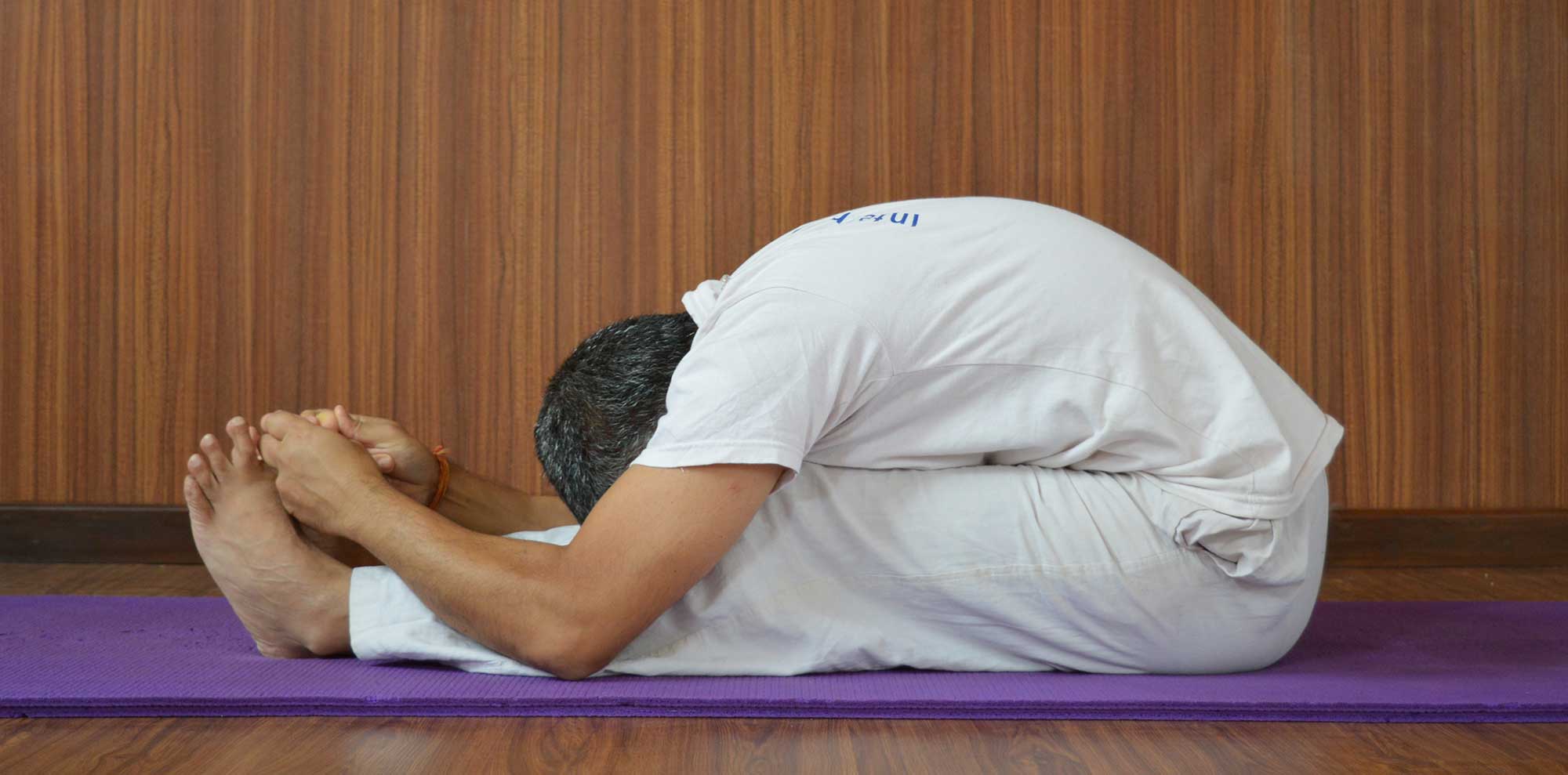
10 Dec 2020 HYN Himalayan Yoga Academy
Prasaarya paadau bhuvi dandaroopau vinyastabhaalam chitiyugmamadhye;
Yatnena paadau cha dhritau karaabhyaam tatpashchimottaanamihaasanam syaat. !!27!!
Meaning
Paschimottanasana is a seated posture in which the upper body is folded forward over the legs to stretch the hamstrings and the muscles of the back. Paschimottanasana is a Sanskrit word, consisting of three words: Paschima means west or back, Uttana means intense stretch, and Asana shows a yoga pose. In Sanskrit, Paschimottanasana is known as पश्चिमोत्तानासन. The yoga pose is pronounced as POSH-ee-moh-tan-AHS-anna. Paschima, meaning “back”; uttana, meaning “stretch”; and asana, meaning “posture”.
In a Shiva Samhita, eighty-four asanas are viewed, but only four asanas are named. One of these is Pashchimmottanasana, while Ugrasana (Fierce or Powerful Pose) is often associated with Pashchimottanasana. Pashchimmottanasana is a classical forward-bending asana from the hatha yoga tradition, as described by ancient sages in classical texts like the Hatha Yoga Pradipeeka and Gheranda Samhita.
Some facts about Pashchimottanasana
- This strongly affects the circulation of the pranic energy and vitality.
- This is an important traditional asana which tones up nerves supplying the pelvic organs and arising from the lumbo-sacral region.
- Pascimottanasana is wonderful preparatory technique for meditational practice as it quickly loosens up the body, removing high states of stiffness and brings the deeper relaxation.
- This is the single yoga pose in yoga, which is known as Ugrasana or Fierce yoga pose.
- Though, it is known as intense dorsal stretch, even though quite effective to combat stress, anxiety, depression, and prepares one for meditation.
- It makes your spine stronger, more refreshed, and supple.
- It is the best back stretching yoga pose when one does the advanced one.
- The asana was advocated by yogi Gorakshanath.
Steps of Paschimottanasana
- First of all, sit on the ground, stretching both the legs outward in Dandasana as a prambhik sthiti.
- Toes should remain together pointing forward.
- Keep the spine erect and toes flexed towards you. Bring your respiration to normal.
- Now, Inhale, raise your arms, and bend the body forward exhaling as far as possible.
- While bending forward, do exhaling.
- Slowly breathe out and bend forward from the hip joint, chin moving toward the toes keeping the spine erect.
- Place your hands on your legs, wherever they reach, without putting much effort. If possible hold of your toes and pull on them to help you go forward.
- Initially, do it for 10 seconds and gradually try to maintain the pose as long as you feel comfortable.
- Inhale and come to the original position.
- This is one round. Initially, do three rounds in beginning.
- As per your practice, you may increase the number of rounds as well as the duration of maintaining the pose.
Merits of Passchimottansana
- It is known for stretching, toning, strengthening, and massaging.
- Paschimotanasana is an excellent asana that gives many advantages.
- The asana stretches and tones the spinal and Hamstring muscles.
- It helps to remove excess fat in the abdominal organs. It is well known for its utility in harmonizing nervous and pranic energies within the body. Makes the belly lean and increases digestive fire.
- It helps to awaken the Kundalini energy.
- Improves peristalsis and overcomes constipation.
- It relieves, indigestion, flatulence.
- This asana helps in the management and prevention of diabetes.
- Alleviates various types of sexual maladies.
- Improves the spinal strength.
Special note
- Relaxation of the back muscle is essential in order to gain proficiency in this asana.
- While bending forward, should bend from lumber and pushing from sacral, but don’t bend from the upper back.
- The violent jerks in order to do asana will strain the back and hamstring muscles.
- Synchronization of the breathing plays very important role in achieving this poses easily.
Contraindications of pashchimottanasana
- Do not force the body to bend forward as it is easy to strain the back. Flexibility comes gradually.
- Pschimottanasana shouldn’t be performed in the following conditions.
- Abdominal ulcer, Asthma, Diarrhea, Back injury, Fracture, Pregnancy, Sciatica, New operation, Slipped Disc, hernia, spondylosis, heart diseases.
Conclusion
In the modern day, due to the increased sedentary life style, the spine is quite prone to stiffness and rigidity. It is good practice to straighten the spine, which is fully stretched during the practice. ‘Somehow, it is also related to ‘the mother system of yoga. ’
